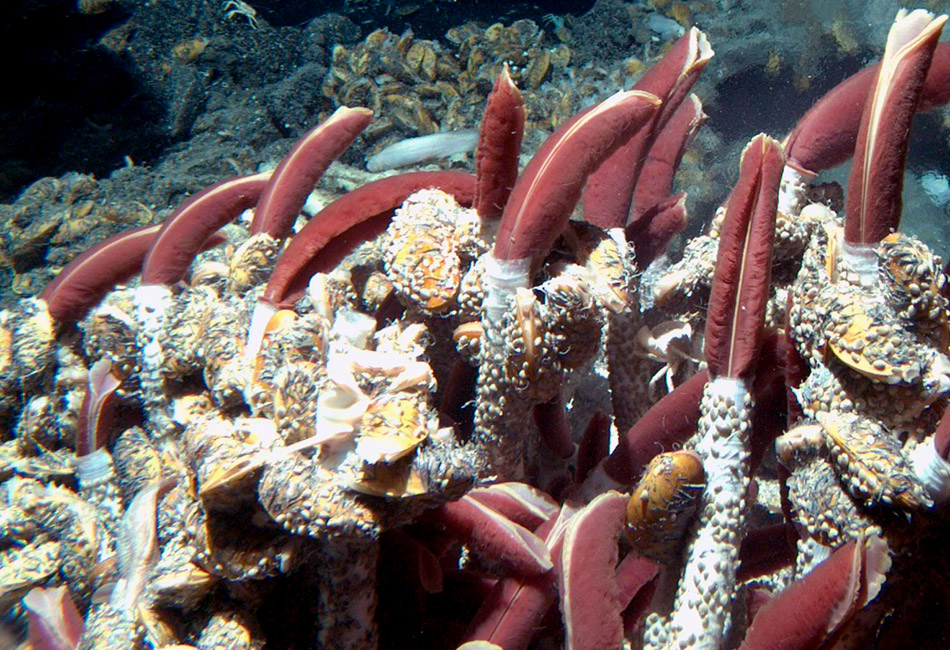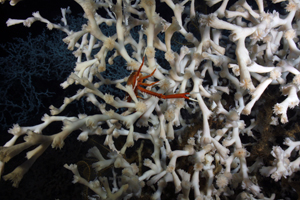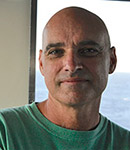Expedition 15:
Jan. 2 - 22, 2014
|
Hot Topics!
Vent Ecosystems 
You Feed Me, I Feed You: Symbiosis Fair Winds and Following SeasJanuary 21, 2014 (posted January 22, 2014) Since dropping off our ailing crew member in Acapulco, life aboard Atlantis has slowed somewhat. Knowledge that the illness he experienced isn’t life-threatening has livened the mood around the ship, and researchers now gather on the mess deck to laugh and talk over a leisurely coffee. Jason team members slowly pack up equipment and start to dismantle parts of the remotely operated vehicle. The driving, 24-hour schedule we've all experienced over the past three weeks has drawn abruptly to a close. “It took me a few days to adjust to the change,” said Chief Scientist Stefan Sievert. “It feels like there’s unfinished business. It’s like if you oversleep before a flight and have to run out the door to the airport—you only realize later what you forgot while you were rushing to leave.” In this case, the forgotten items aren't a toothbrush or t-shirt, but samples and measurements of life on the sea floor. Even with the expedition cut short by a few days, Sievert said this cruise has been incredibly successful. Thanks to Jason, we were able to spend more than 300 hours—that's 12 and a half days—at the seafloor, gathering samples, taking measurements, and exploring the hydrothermal vents. The researchers were able to examine vents like Crab Spa in great detail, collecting data that will help them understand the complex relationship between chemistry and biology at the site. In their labs back home, they’ll analyze the vent’s fluid and study the ways that microbes living near it change the chemistry of the fluid. They’ll even begin to uncover the processes that go on inside those microbes as they make a living at the vent. “Not many studies have looked at a single site in this much detail before,” said Sievert. “We think Crab Spa will be a good representation of similar vents, so we can use what we find out here as a model for other sites.” Packing upIn the ship’s labs, most work has stopped, but a few Isobaric Gas-Tight samplers (IGTs) full of vent fluid remain. As long as those samples last, researchers can use them to run some final experiments. Jesse McNichol and François Thomas will grow one last batch of microbes inside some of the IGTs to count cell numbers and measure their chemistry. Dionysis Foustoukos, Ileana Pérez-Rodríguez, and Matt Rawls will use other IGTs to continue their flow-through experiments. They’ll finally pack up once the fluid runs out in a day or two. They will have plenty of work to do back on land, too. They still have to look at their data and make sense of the results. They'll also analyze the genes of the microbes. “Any time we change the conditions inside our experiment, like the pressure or temperature, different species of microbes will start to grow and take over the population,” said Pérez-Rodríguez. Since every species has different DNA, the researchers can use it to tell who’s coming out on top. There may also be undiscovered species of microbes in the mix—an exciting prospect for any microbiologist. “Who knows? New microbes might be in this lab as we speak!” she said. Moving ForwardOn shore, the collaborations that played out on this cruise will continue as the team shares data with researchers across the U.S., France, Germany, and China. In the coming months, the scientists will meet regularly, either in person or via the internet, to trade information. “That’s what so unique about this research,” Sievert noted. “The fact that we’re supporting each others’ work will help us gain new insights on how life works at the vents.” Jeff Seewald and Nadine Le Bris, who are measuring the chemistry of the vent sites, will help provide information on the amount of chemical “food” available to microbes near the sea floor. The incubation experiments done in Atlantis’ main lab will offer clues to the microbes’ metabolism—how they use those chemicals to survive, and how they change the chemistry of the vents in the process. The data will support Costa Vetriani’s work on biofilm formation at vent sites, and may also help scientists understand symbiotic bacteria that live inside tubeworms and mussels. Finally, Leonid Germanovich’s flow measurements will allow the scientists to determine the rate at which vent chemicals and microbes mix into the deep ocean. “What sort of chemicals and microbes are coming from the subsurface? How much of it is there? How much of it is transported away from the vents?” asked Sievert. “Knowing that, we can start to figure out how vent chemistry and microbiology affect the rest of the ocean.” This constant sense of discovery, playing out both at sea and on land, is a big part of what keeps the scientists going—and as our time on Atlantis winds down, their work is only just beginning. As for Dive and Discover, we’ll continue posting interviews and other content through the end of this week as we return to Panama, so please check back over the next few days. In the meantime, I would like to thank WHOI’s Deep Ocean Exploration Institute, Ocean Life Institute, and Access to the Sea Program for their generous support. I also want to thank all of you, our readers, for following the expedition, and for sending your excellent questions to the Mail Buoy.
Get to know the crew
Lance Wills, able-bodied seaman on the Atlantis, has spent 30 years working on ships of all sorts, from fishing boats to research vessels. Over the years, he’s picked up plenty of good stories. He also picked up photography skills and a master’s degree in journalism. When he’s not standing watch on the bridge, Wills is often writing in his cabin and has penned several books here on the ship. Read the interview » [ Previous update ] [ Next update ]
|
Mailing List | Feedback | Glossary | For Teachers | About Us | Contact
© 2013 Dive and Discover™. Dive and Discover™ is a registered trademark of Woods
Hole Oceanographic Institution



